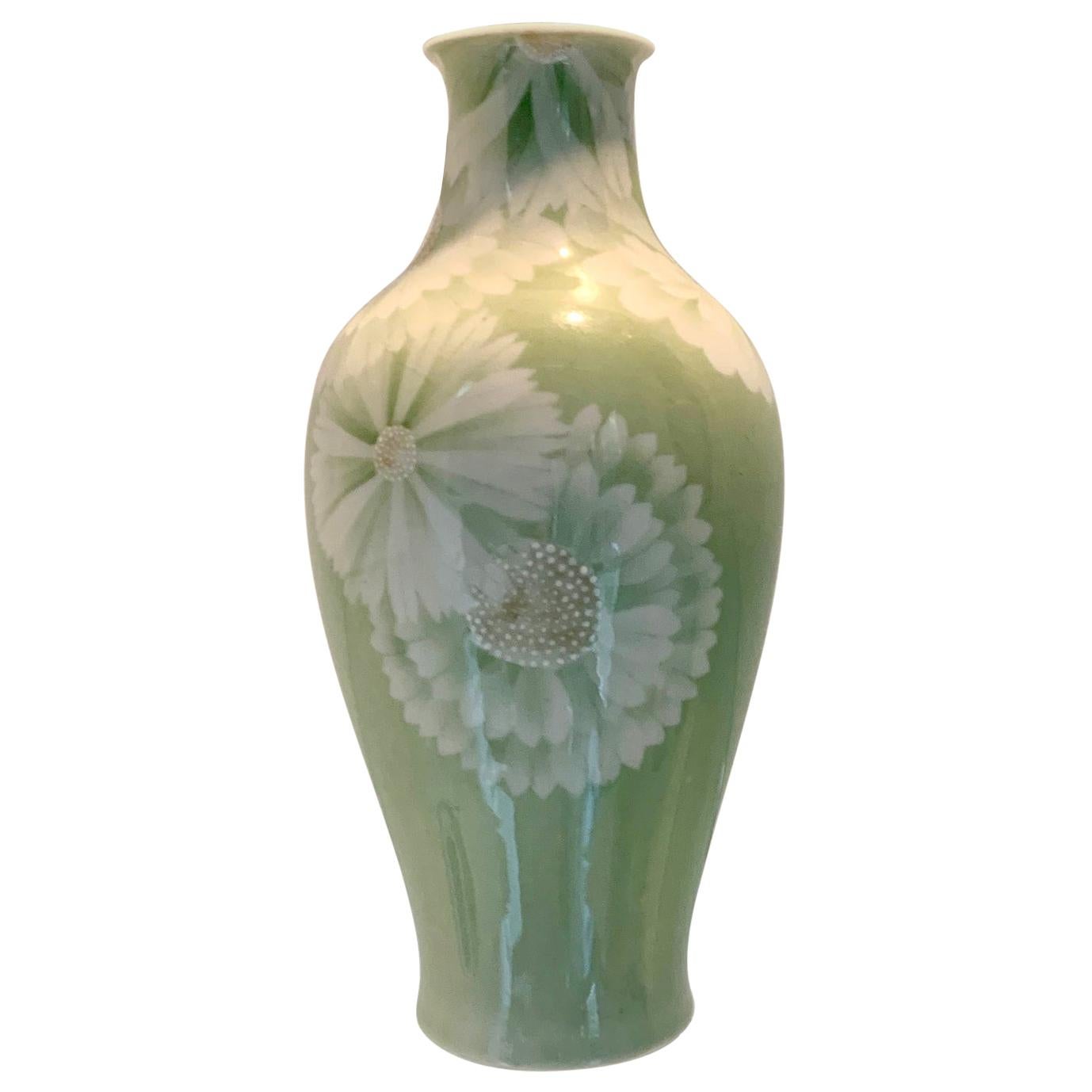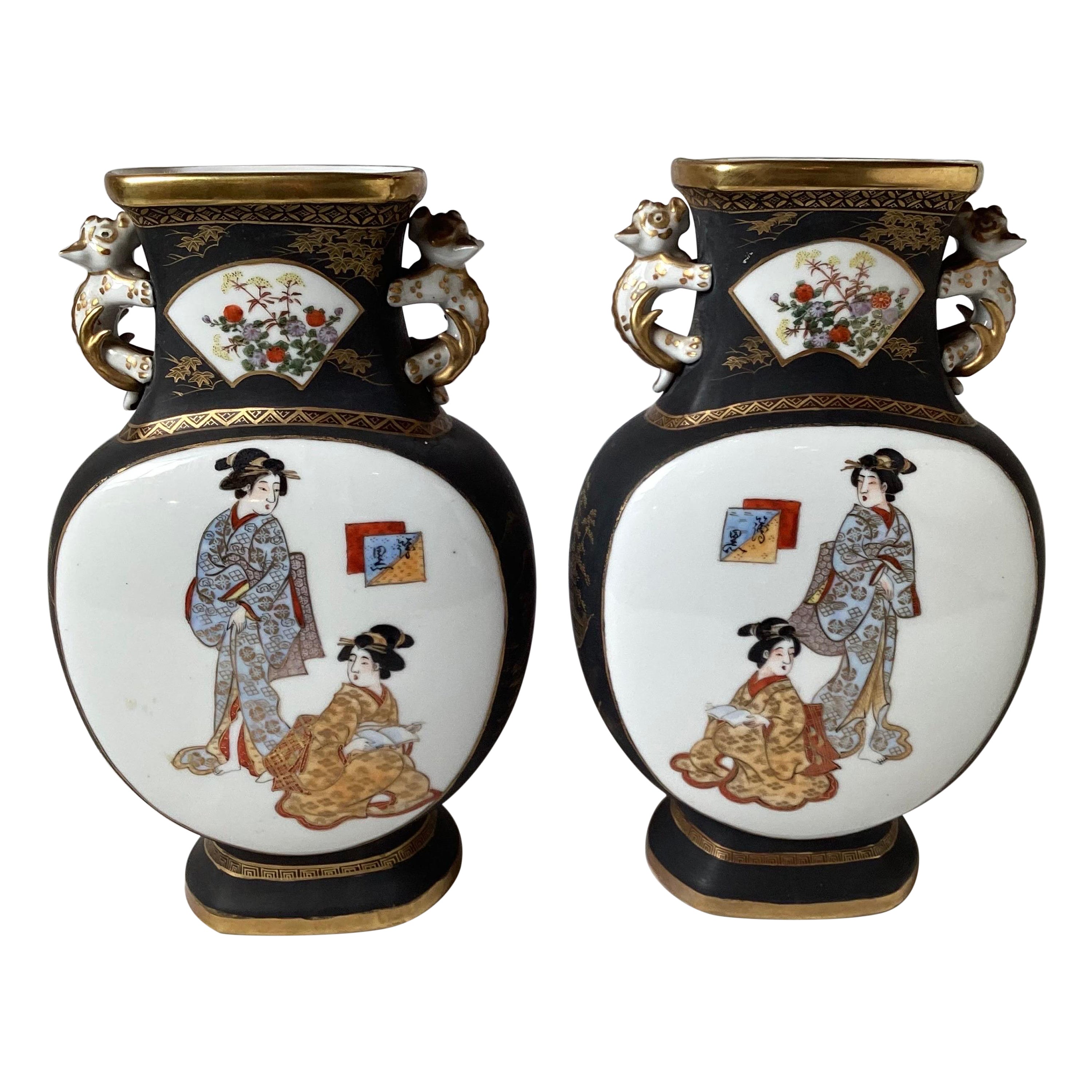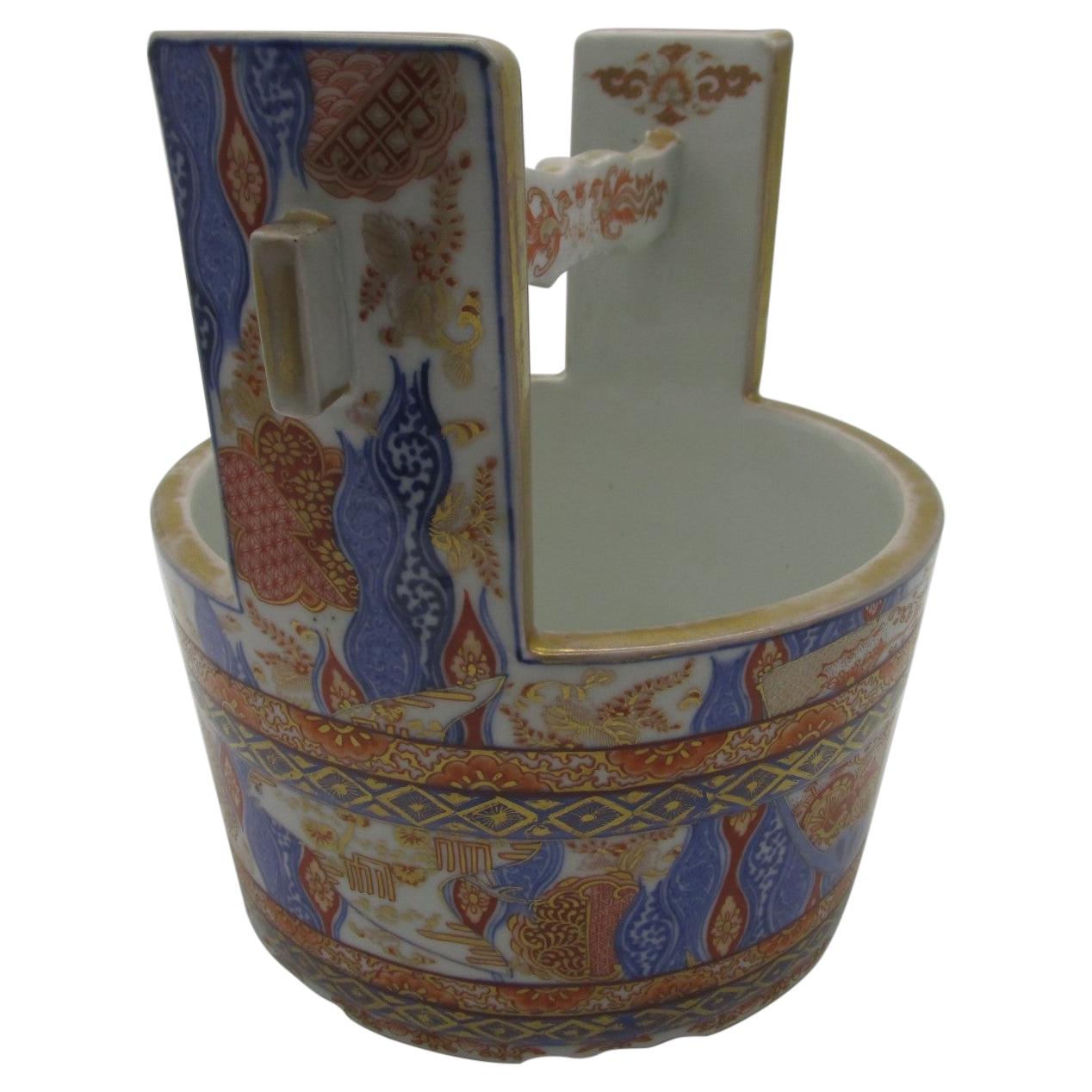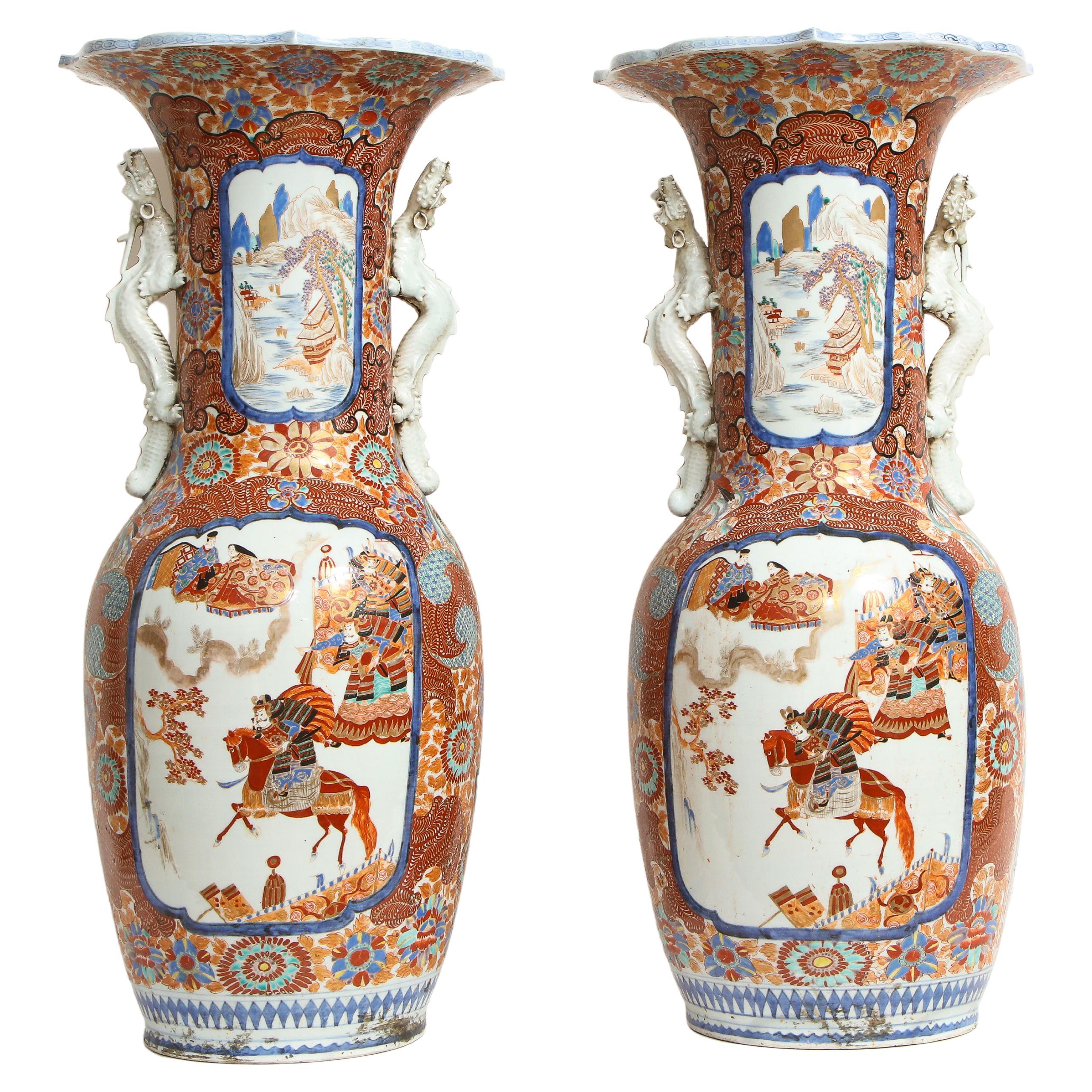Items Similar to Pair of Japanese Late Meiji Period Fukagawa Porcelain Vases, circa 1900
Video Loading
Want more images or videos?
Request additional images or videos from the seller
1 of 15
Pair of Japanese Late Meiji Period Fukagawa Porcelain Vases, circa 1900
About the Item
Superb pair of Japanese large Meiji period Fukagawa signed porcelain vases (circa 1900). Intricately hand-painted in cobalt blue underglaze with polychrome and gold overglaze on a stunning bottle-shaped body featuring an elegant long neck, set against a pure white background that is the characteristic of Imari-Arita porcelain.
The Mt. Fuji and flowing water kiln mark is the signature of the Fukagawa Seiji Company established in 1894 by Chuji Fukagawa, the son of the founder of the famed Koransha Kiln (Scented Orchid Company) created in 1875. Fukagawa Seiji gained worldwide acclaim after winning the Grand Prix in the Paris World Exposition of 1900.
This pair of porcelain vases was created at about the same time as the 1900 Paris World Exposition. They feature scenes from the Nagasaki Dragon Dance Festival (with roots in the 18th century) and showcase a complicated combination of stunning patterns on diamond shape panels. Numerous intricate flower and bird motifs cover other areas of these breathtaking vases. The two porcelain vases are in excellent condition.
The late father of the collector of this exquisite pair, who operated one of the leading kilns in the historic Imari-Arita region of Japan, travelled extensively throughout Europe in the 1960s with a mission that he led to purchase and bring back to Japan antique ceramics that had been exported from Japan to the West over the past 250 years. A total of 104 pieces were acquired and brought back. These were very unique pieces, designed and produced to export to Europe and later to America too, mostly in the 18th up to very early 20th century. These were carefully studied and extensively copied in the hope of creating products that conformed with the long-standing tastes and preferences in the west and bringing back the glory of that era. He concentrated on purchasing massive masterpieces that originated from his region of Imari-Arita. Records show that the mission did a considerable portion of its buying in London. All the 104 pieces have been in his museum quality private collection. This pair of Meiji period porcelain vases (circa 1900) is among these 104 exceptional and unique pieces.
Dimensions: H 13.5 in, D 13.5 in.
- Dimensions:Height: 13.5 in (34.29 cm)Diameter: 13.5 in (34.29 cm)
- Sold As:Set of 2
- Style:Meiji (Of the Period)
- Materials and Techniques:
- Place of Origin:
- Period:1900-1909
- Date of Manufacture:circa 1900
- Condition:Wear consistent with age and use. This set of Meiji porcelain vases is in perfect condition. There are no cracks, chips or restorations.
- Seller Location:Takarazuka, JP
- Reference Number:1stDibs: LU2771324034212
About the Seller
5.0
Gold Seller
These expertly vetted sellers are highly rated and consistently exceed customer expectations.
Established in 2009
1stDibs seller since 2017
211 sales on 1stDibs
Typical response time: 1 hour
- ShippingRetrieving quote...Ships From: Takarazuka, Japan
- Return PolicyA return for this item may be initiated within 7 days of delivery.
More From This SellerView All
- Japanese Meiji Period Fukagawa Porcelain Charger, circa 1890sLocated in Takarazuka, JPExquisite late 19th century Japanese Fukagawa porcelain charger, circa 1890s, Meiji period (1868-1912).It depicts rocks and auspicious chry...Category
Antique 1890s Japanese Meiji Decorative Dishes and Vide-Poche
MaterialsGold
- Japanese Meiji Porcelain Water Bucket Vase, circa 1880Located in Takarazuka, JPJapanese porcelain water bucket vase or teoke from early Meiji era, circa 1880, exhibiting beautiful hand-painting in underglaze cobalt blue and polychrome...Category
Antique Late 19th Century Japanese Meiji Vases
MaterialsGold
- Pair of Edo Period Japanese Blue Red Gold Porcelain Vases, Circa 1800Located in Takarazuka, JPExquisite pair of mid Edo period large Japanese Ko-Imari porcelain vases in an attractive baluster shape boasting intricate patterns of floral and highly detailed geometric motifs that beautifully intertwine on the body of the handsome vases, creating captivating landscapes in dark blue, orange and gold details throughout, which is characteristic of Imari porcelain from the Edo Period. The two scalloped cartouches on each vase with highly decorated and elaborate borders recreate the pine, plum and bamboo motif known as “Sho-Chiku-Bai” or the “Three Friends of Winter.” The impressive pine trees in cobalt blue decorated with gold details dominate the landscape on white background. The two small delicately scalloped cartouches appearing in the middle of the long neck of the vases depict playful rabbits among trees. The late father of the collector of this exquisite pair, who operated one of the leading kilns in the historic Imari-Arita region of Japan, travelled extensively to Europe in the early 1960s with a mission that he led, to purchase and bring back to Japan antique ceramics...Category
Antique Early 19th Century Japanese Edo Vases
MaterialsGold
- Japanese Blue Purple Porcelain Vase, circa 1935Located in Takarazuka, JPJapanese mid 20th century signed decorative porcelain vase (circa 1935,) from Showa period (1926 to 1985). It depicts an attractive safflower motif, an elegant scene hand-painted in purple and underglaze blue on a pure white background, on a beautifully shaped porcelain body. The artist's signature appears at the reverse side of the vase. This exquisite vase is in excellent condition. The late father of the collector of this exquisite pair, who operated one of the leading kilns in Imari-Arita region of Japan, travelled extensively to Europe in the early 1960s with a mission that he led, to purchase and bring back to Japan antique ceramics...Category
21st Century and Contemporary Asian Meiji Vases
MaterialsPorcelain
- Japanese Early Meiji Period Porcelain Bowl, circa 1870Located in Takarazuka, JPExceptional Japanese early Meiji period (circa 1870) signed Imari ribbed porcelain Bowl, extremely intricately hand-painted on both sides in cobalt blue underglaze and polychrome en...Category
Antique 1860s Japanese Meiji Ceramics
MaterialsGold
- Porcelain Vase by Japanese Master ArtistLocated in Takarazuka, JPExquisite Japanese contemporary porcelain decorative vase, hand painted in vivid blue and red on an elegant bottle shape body, a signed piece by highly acclaimed Japanese master porc...Category
21st Century and Contemporary Japanese Meiji Vases
MaterialsGold
You May Also Like
- Japanese Porcelain Vase Meiji Period Makuzu KozanBy Makuzu KozanLocated in Atlanta, GAA finely decorated and glazed Japanese porcelain vase by Makuzu Kozan (1842-1916) circa 1900s Meiji Period. The vase is of a classic bottle form with baluster body and short neck. It was decorated with underglaze white magnolia blossom on a pleasant celadon background. The stamens of the flower were artistically rendered in a low relief, giving the design a realistic appeal with the dimension. Miyagawa Kozan...Category
Early 20th Century Japanese Meiji Ceramics
MaterialsPorcelain
- Pair of Meiji Period Japanese Hand Painted Moon VasesLocated in Lambertville, NJA pair of hand painted Japanese Moon vases with foo dog handles. The porcelain vases with hand painted Geisha figures on both sides, the fronts wi...Category
Early 20th Century Japanese Meiji Ceramics
MaterialsPorcelain
- Japanese Porcelain Vase Makuzu Kozan Meiji PeriodBy Makuzu KozanLocated in Atlanta, GAA striking blue and white vase from the studio of Japanese Potter Makuzu Kozan, also known as Miyagawa Kozan (1842–1916), one of the most established and collected ceramist from Meiji Period. Born as Miyagawa Toranosuke, Kozan established his pottery studio in Yokohama circa 1870s and later became one of the appointed artists to the Japanese Imperial household. His work was exhibited in many international fairs that the Meiji government participated at the turn of the century and won many grand prizes. Of a relatively large size, this vase is decorated with underglaze cobalt blue using the novel technique developed by Kozan called Fuki-e (the blow painting). As a result, the bamboos appear took on a three-dimensional quality as if appearing in a mist. Known as one of the most creative ceramists, circa 1887, Kozan started experimenting with new chemical colors from the West in the format of his porcelain glaze. New colors allowed him to create underglaze design that appeared bright, smooth and glossy. He even invented his own receipt of cobalt blue to achieve a much brighter yet softer shade, as evident on this vase. To create landscape that is realistic and dimensional, more common in the western paintings, he was inspired by the native Japanese ink painting technique developed around 1900 by Yokoyama Taikan...Category
Antique Early 1900s Japanese Japonisme Ceramics
MaterialsCeramic
- Pair of Japanese Meiji Period Imari Vases with Dragon HandlesLocated in New York, NYA Monumental pair of Japanese Meiji Period Imari vases with Dragon handles, Japanese Porcelain Studio Marks on Underside. Each is beautifully ...Category
Antique 1880s Japanese Meiji Ceramics
MaterialsPorcelain
- Antique Meiji Period Kutani Japanese Porcelain Temple JarLocated in Lambertville, NJAntique Meiji period Japanese porcelain temple jar with intricate hand painted decoration and gilt. The jar in Classic Kutani colors with floral and phoenix birds all over the top an...Category
Antique 1880s Japanese Meiji Ceramics
MaterialsPorcelain
- Medji Period High Relief Porcelain Celadon Vase, circa 1900Located in Miami, FLThis captivating Medji period (1868-1912) porcelain vase features a mesmerizing celadon glaze, with a subtle crackled texture. Exquisite details, meticulously hand-painted in vibrant...Category
Early 20th Century Japanese Meiji Vases
MaterialsPorcelain
Recently Viewed
View AllMore Ways To Browse
Meiji Japanese Vase
Vases Japan Pair
Pair Japanese Vase
Pair Of Japanese Vases
Mounted Chinese Vase
Antique Japanese Porcelain Vase
Antique Japanese Porcelain Vases
Antique Japanese Porcelain Vase Vases
Pair Of Vases 1900
18th Century Pair Vases
Pair Set Of Vase
Pair Of Antique Japanese Vases
Export Vases Pair
Antique Japanese Flower Vases
Meiji Period Vase
Japanese Meiji Period Vases
Blue White Porcelain Pair Vase
Pair Of Blue And White Porcelain Vases





